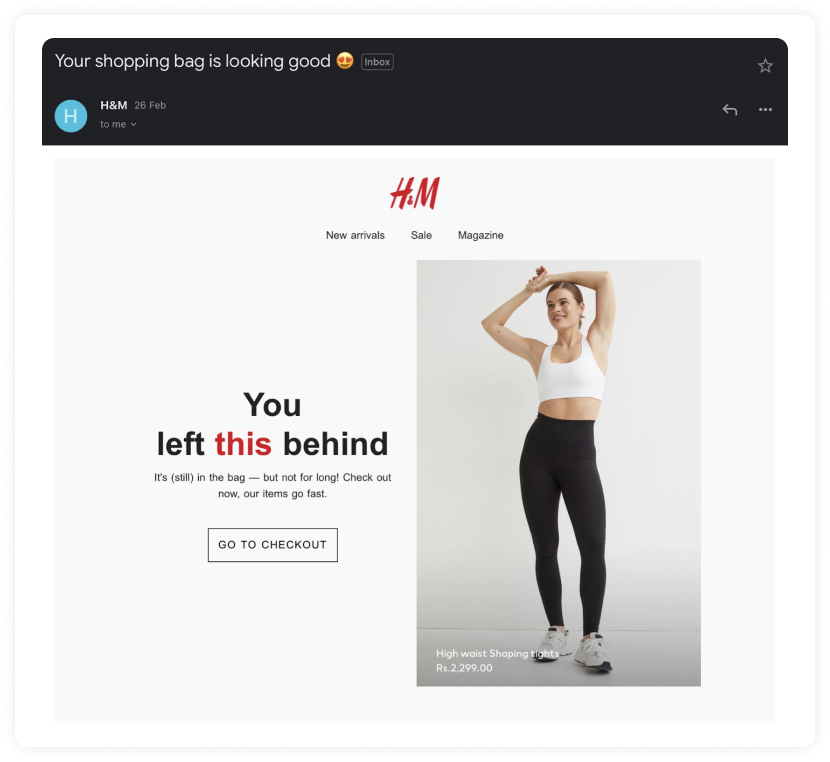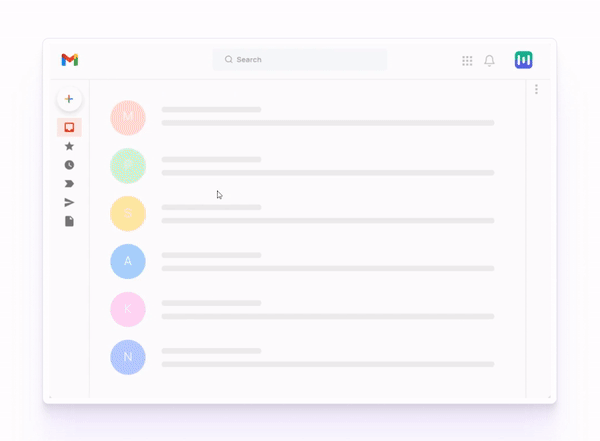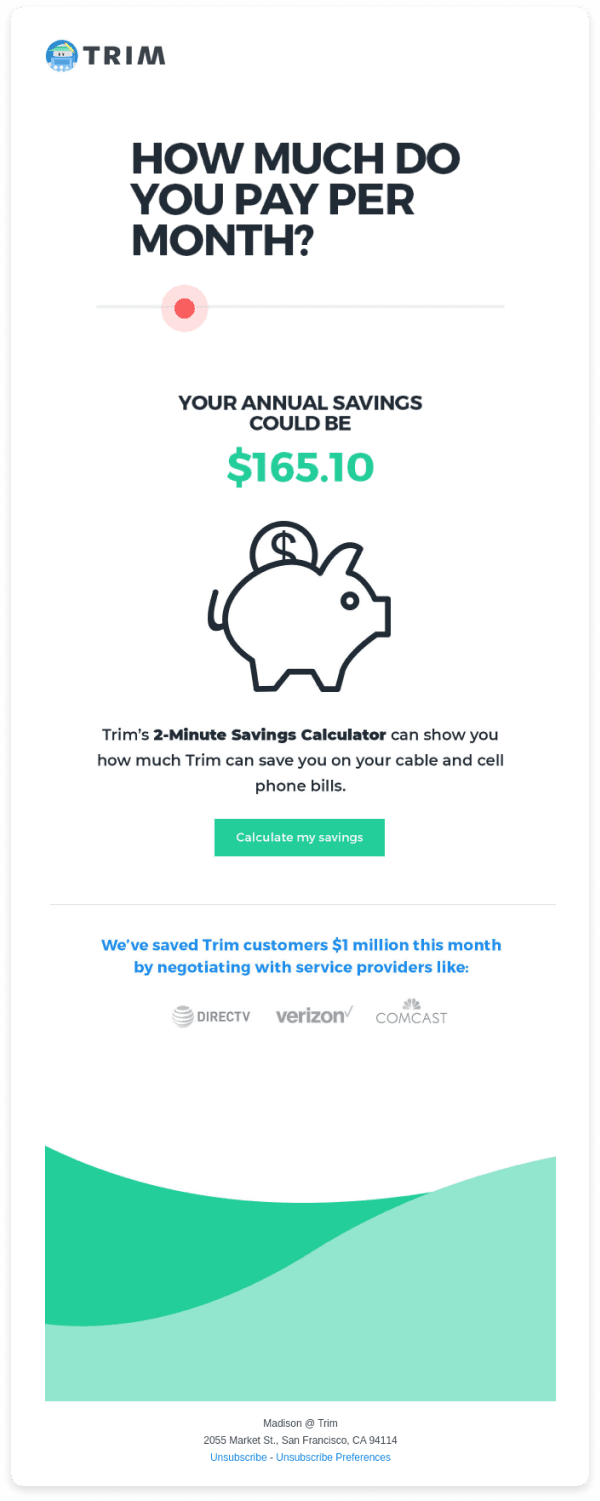What is email retargeting?
Email retargeting is a marketing strategy where you send highly targeted emails to people based on their interests and behavior to get them to convert and take action. The action can be anything like making a purchase, registering for a webinar, downloading a lead magnet, etc.
In the example below, Netflix uses email retargeting to show people what they recently watched and provides similar recommendations to get people to continue watching Netflix.

Source: Really good emails
How does email retargeting work?
Email retargeting works by tracking your customer activity on your website and using the existing data you have on your customer to send highly targeted and personalized emails to them.
Many email marketing platforms allow you to send retargeting emails based on various behavioral triggers. A trigger is an event on your website or store based on an email sent to the customers.
For example, when a customer adds a product to the cart and hasn't completed the checkout process, you can use this as a trigger to send the email campaign to nudge them to complete the purchase.
Here is an example of an abandoned cart email flow to send retargeting emails:

Why should you send email retargeting campaigns?
Email retargeting can be beneficial for the following reasons:
Reconnect with your audience
You can re-introduce yourself to your existing audience who might have forgotten about you. Your existing audience would have probably been interested in your products and services, so re-introducing your brand with retargeting email campaigns can help you reconnect with them.
Convert website visitors into paying customers
If someone has visited your website, browsed through your products or services, and left without buying anything, it is a terrible loss of potential revenue. You will likely get at least 10% more conversions from sending these retargeting email campaigns than you would if you don't send them.
You can analyze your visitor behavior using analytics tools and use these insights to send emails to retarget them with the same content.
For example, if someone added items in their cart but didn't check out, you can send them cart abandonment emails, as H&M has done in the example below.


Retain your past customers and make them a repeat customer
Your past customers have trusted you and bought your product or service. So, it's easier to send them retargeted emails to cross-sell or upsell products.
Cross-selling encourages customers to purchase products or services based on items purchased. In comparison, upselling is when you get people to buy a higher-end version of a product.
And, when you send them highly relevant and targeted cross-selling or upselling emails based on their previous purchase, they are likely to make another purchase from you as the product or service might be useful for them.
Increase your conversion rate
The advantages mentioned above ultimately lead to an increase in conversion rates as you have pursued potential buyers and targeted them in a way that will get them to buy your product or service.
And according to SaleCycle, retargeting emails can give an average 30% conversion rate, whereas the average conversion rate is usually under 5%.
Who can you retarget?
Now that you know what email retargeting is, you must have felt that it is not a normal email campaign you can send to everyone. And that's true. So who can you send these retargeting email campaigns to? Here are a few ideas as to who you can send retargeting emails:
1. Inactive subscribers
Inactive subscribers can be anyone who has not opened, clicked on your emails, or any parameter you want it to be. Removing such subscribers from your list is recommended if they have been inactive for more than six months.
But, before you do that, it's alright to give them one last shot and send them retargeting emails to see if they take action or not. You can use the data collected from signup forms to create targeted emails for them.
If they still don't respond to your emails, you can sunset them and put them in a suppression list.
2. Website visitors
Website visitors can be:
Active
Active users can be classified as people who have signed up for your email list, purchased from you, or downloaded your lead magnet.
Passive
People who have visited your website and browsed around but have not taken action.
You will mostly target passive website visitors as they have not taken action. And, since they have shown some interest in your product or service, you can coax them to convert using special offers.
You can get information about your site visitors using website cookies, where you can see who visits your site and what they look at. You can also check to see if there are any specific categories or pages they are interested in.
With this information, you can send retargeted emails to hopefully reignite interest and get them to buy it.
3. Active audience
Active audiences are people who have previously purchased from you. It can be an old or recent customer. You can use email retargeting through cross-selling campaigns to send people products they might be interested in based on their previous purchases.
4. Churned users
Churned users are people who have stopped using your product or service. You can look at such users' purchase history to determine why they stopped using your products and the issues they faced.
After which, you can send them targeted emails addressing the issues and providing possible solutions. Or you can email them about their feedback or reason for churn. Then, use that data to send retargeting campaigns.
Also, we suggest you not wait until a user has churned before you send them an email but rather ask for their feedback right after the first interaction. Studies show a reduced customer churn of about 67% if businesses resolve the issue at the first engagement.
Types of email retargeting campaigns with examples
There are numerous retargeting emails you can send. Here are a few popular ones with an example.
Abandoned cart
Abandoned cart emails are the most common retargeting email that any email marketers send to their customers. It will be triggered when someone leaves the product in the cart without purchasing it.
Here's an example of an abandoned cart email:

Another example of the same category is browse abandonment emails sent to people who viewed your products but have not added them to the cart.

Reminder to upgrade
Plan upgrade emails are another great example of retargeting emails where you can nudge customers to upgrade their plan before their trial period ends.
In this example, ON X reminds its customers that their trial period is ending and nudges them to upgrade their plan.

Source: ReallyGoodEmails
Service feedback
The most important use case of retargeting is to retain your customers. What else could be more helpful to retain them than getting feedback and constantly improving your service?
Here's an example of a service feedback email from MeUndies that asks for feedback from customers about their membership.

Engagement emails
Engagement emails are sent to inactive subscribers to re-engage and make them active members of your community. To pick inactive subscribers, you must monitor their behavioral data constantly. Most ESPs let you analyze the engagement rate.
Here's an example of an engagement email from Trim.

Source: ReallyGoodEmails
Upselling emails
Send upselling campaigns to get the customer to purchase premium plans or upgrades, as Grammarly has done in the example below.

Product recommendation
Product recommendation emails can be a great way to get your customers back to shopping on your online store. You can send products related to your customer's purchase history and nudge them to make a purchase.
Here's an example from Lyst:

Source: ReallyGoodEmails
How to send retargeting emails?
Now that you know all the details let's find out how to create and send retargeting emails.
Step 1: Divide your audience into segments
You have an image of who you want to send retargeting emails to, so now you have to segment your audience into smaller groups. You can segment based on common characteristics like age, gender, geographical location, etc., to make it easy to track what campaigns to send to who.
By segmenting your audience, you can target specific groups of people and send them relevant emails with what they want to see. It also ensures that you are not sending emails to the wrong audience members, like cart abandonment emails to people who've already made the purchase.
You can go wild with the segments and make them as specific or general as you want to. It can even be like "Women in the age range of 20-30 who have shown an interest in X product but haven't bought it yet". Such specific segments can help you find a clear way to target them and personalize their content.
"Always use remarketing lists that are updated daily or weekly, so that you are retargeting the most qualified leads at any given time. It’s also important to set up tracking pixels on all pages of your site to monitor user behavior. This behavior is what will inform your decisions on which leads to send retargeting emails to, and which ones to leave alone. You should also highly consider tracking clicks and impressions in Google Analytics for better optimization of your email retargeting campaigns."
- Lisa Richards, CEO and Creator of the Candida Diet
Step 2: Create the retargeting campaign
It's time to create the actual campaign you'll be sending out. And for that, you need to consider all the information you have gathered so far and use that to create a targeted email with content relevant to the user's interests or activity, as in the example below.

Source: Really Good Emails
Personalize the content like subject line (which we see later in this article), CTA, and copy to help connect with your target audience and make them want to convert. You can also use dynamic content to save time and create campaigns relevant to different audience segments.
While creating the campaign, make sure to make it personal, and include social proof and incentives. Social proof can help build trust, and incentives can help motivate them to make the purchase.
Step 3: Send out the campaign at the right time
Now that you have everything ready, it's time to go ahead and send out the campaigns. Add your target audience to your email service provider (ESP) and send out the campaign at the best time.
You will have to start sending your retargeting emails soon after someone's clicked off your website. If you send them the emails soon, they are more likely to remember, return to your website, and convert.
Finally, set up automation to save time and automatically send retargeting emails to appropriate people based on their behavior.
5 best practices to send better retargeting email campaigns
As with any email marketing campaign, you have to follow the best practices to get better results for your effort. Here are some best practices you can follow to ensure that your emails add value to your business.
Make sure your emails are timely and relevant to the audience.
Always segment your audience to craft personalized emails.
A/B test your email subject lines to improve open rates.
Emphasize your offering and CTA on your retargeting email.
Use dynamic email content to send hyper-personalized emails.
Use testimonials to convince them to take action.
Few subject line tips to boost our retargeting email open rates
The subject line is the first thing that gets your customers' attention. So make sure it is attractive and makes your customer open the email. Here are some tips to improve your retargeting email subject lines,
Create a sense of urgency with phrases like 'Hurry up,' 'Clock is ticking,' and 'Offer ends in 24hrs.'
Share the offer directly - '30% discount coupon is waiting for you.'
Add personalization - 'Hey, [name]! You got a free shipping code.'
Remind them about the product they viewed - 'Hey, [name]! Red hoodie is back in stock.'
Hint about exclusivity - 'Hey, [name]! 1000 free credits only for you.'
















































